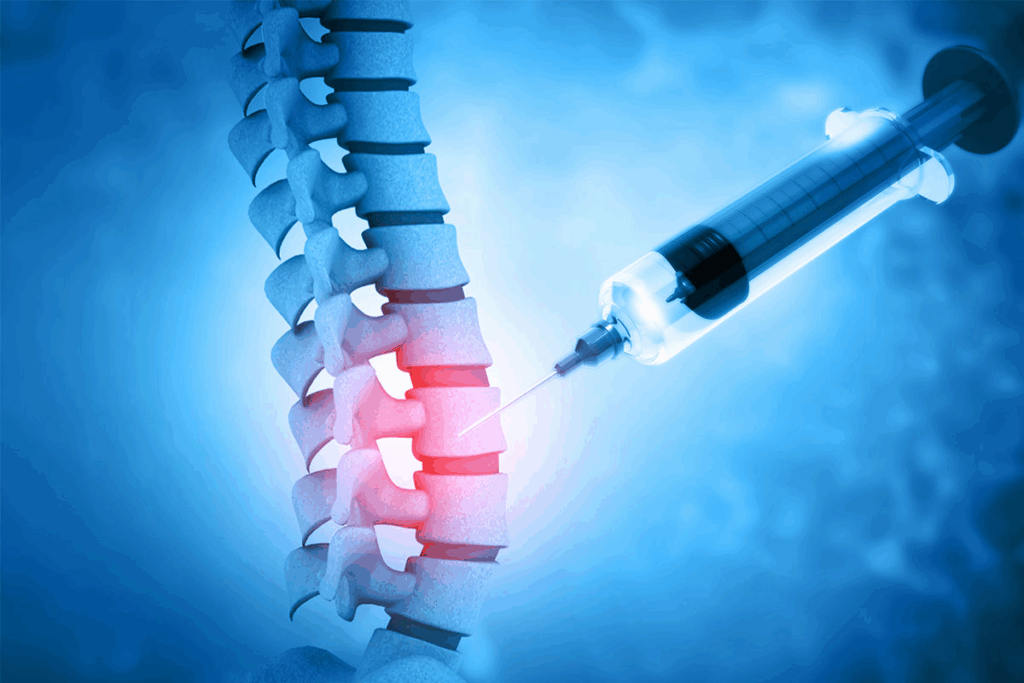
Managing back pain can be tough and frustrating. Lumbar facet injections are a common treatment for back pain, like at L4-L5. At Liv Hospital, we think it’s key to know about the complications associated with these injections. Learn 13 important facts about side effects of lumbar facet injections and safety tips.
Facet joint injections help with pain from osteoarthritis, spondylosis, and spinal stenosis. As a patient-focused healthcare provider, we want you to know the risks and benefits of this treatment.

To grasp the value of lumbar facet injections, we must first know about facet joints. These small joints are between and behind vertebrae in the spine. They help stabilize and move the spine.
Facet joints connect vertebrae, allowing for spine flexibility and support. When they get inflamed or irritated, they can cause a lot of pain. The lumbar facet joints bear a lot of weight, making them prone to strain.
Facet joint inflammation or irritation can come from many sources. This includes degenerative changes, trauma, or repetitive strain. It leads to pain in the lower back, sometimes spreading to other areas.
Lumbar facet injections are often given at specific spine levels. The L4-L5 level is a common target. This is because the L4-L5 facet joint is under a lot of stress and often causes pain.
| Spinal Level | Frequency of Injection | Reason for Injection |
| L4-L5 | High | High stress and mobility |
| L3-L4 | Moderate | Significant load-bearing |
| L5-S1 | Moderate | Transition zone stress |
Lumbar facet injections have both diagnostic and therapeutic uses. They help figure out if facet joints are causing pain by numbing the area. They also deliver medication to reduce swelling and pain.
Understanding facet joints and lumbar facet injections helps healthcare providers manage back pain better. This knowledge is key to creating effective treatment plans for each patient.

Exploring lumbar facet injections, we see a variety of side effects patients might face. These injections are a common treatment for back pain. Knowing the possible side effects helps patients make informed choices.
Local pain and tenderness at the injection site are common side effects. This discomfort is usually short-lived and can be eased with over-the-counter pain meds. It’s important to talk to your healthcare provider about managing pain.
Swelling and bruising at the injection site can happen. These symptoms are usually mild and go away in a few days. Using ice packs and elevating the area can help reduce these effects.
Some people may feel temporary numbness and weakness in their lower back or legs after the injection. These symptoms are usually short-lived and go away on their own.
It’s common for symptoms to get worse before they get better after lumbar facet injections. This can be due to the injection itself or the body’s reaction to the medication. Most of the time, symptoms start to improve as the treatment works.
| Common Side Effects | Frequency | Typical Duration |
| Local Pain and Tenderness | Common | 1-3 days |
| Swelling and Bruising | Uncommon | 2-5 days |
| Temporary Numbness and Weakness | Rare | 1-7 days |
Knowing about these side effects helps patients prepare for the procedure and understand what to expect during recovery. While lumbar facet injections are generally safe, being aware of possible side effects helps manage them better and avoids surprises.
Some patients may feel more pain and swelling after facet injections. This is because of the corticosteroid used to ease facet joint pain. It’s a common side effect.
A steroid flare happens when the body reacts to the corticosteroid in facet injections. This can irritate and swell the joint, causing more pain.
The length and severity of a steroid flare can differ. Usually, it’s short-lived and goes away in a few days.
To manage a steroid flare, you need to reduce swelling and pain. There are several ways to do this.
Knowing what causes a steroid flare and how to handle it can help patients deal with this side effect of facet injections.
Corticosteroids in facet injections are usually safe. But, they can have systemic effects that patients should know about. These effects happen because the steroids can spread through the body, affecting different systems.
Some people might get hot flashes or facial flushing after facet injections with corticosteroids. These symptoms are usually short-lived and go away by themselves.
Corticosteroids can change blood pressure and blood sugar levels. People with high blood pressure or diabetes should watch their conditions closely after getting facet injections.
Mood swings, like feeling irritable or overly happy, can happen due to corticosteroids. Some might also notice they’re hungrier.
Corticosteroids can weaken the immune system temporarily. This makes patients more likely to get infections. It’s important to follow the care instructions after the procedure to lower this risk.
Knowing about these possible systemic effects can help patients get ready for their treatment. It’s good to talk to your healthcare provider about any worries before getting facet injections.
Facet injections carry some risks. Serious complications are rare but can have big effects. It’s key for patients to know these risks to make smart choices about their treatment.
Infection is a rare but serious side effect of facet injections. We use strict precautions to lower this risk. This includes using clean equipment and proper injection methods.
It’s important for patients to watch for signs of infection after the procedure. Look out for increased pain, redness, or fever.
Spotting and treating infection early is key to avoiding serious problems.
Bleeding can happen with facet injections, but it’s rare. People on blood thinners or with bleeding disorders are at higher risk. We check these factors before doing the injection.
Risk factors for bleeding complications include:
Nerve damage is a possible complication, but it’s not common. Symptoms can be numbness, tingling, or weakness. How often nerve damage happens depends on the procedure and the patient.
Symptoms of nerve damage may include:
Allergic reactions to facet injection substances are rare but possible. We screen carefully to reduce this risk. Symptoms can range from mild to severe.
If you see these symptoms, get medical help right away.
Cervical facet injections have unique risks compared to lumbar facet injections. Both are used to ease pain from facet joints. But, the cervical and lumbar spine are different, leading to different side effects.
The cervical spine is delicate and has important structures like the vertebral arteries and spinal cord. Injections here need to be done carefully to avoid problems. There’s a risk of vascular complications because of the close location of the vertebral arteries.
Neck injections can lead to serious vascular complications. Injecting corticosteroids into the vertebral artery or its branches can cause stroke or spinal cord injury. We must weigh the risks and benefits for each patient carefully.
Recovery from facet injections varies between the cervical and lumbar regions. Patients often recover faster from lumbar injections than cervical ones. This is because of the muscle mass and anatomy differences.
Cervical facet injections might not be suitable for some patients. This includes those with a history of stroke, significant vertebral artery stenosis, or other vascular issues. We need to check each patient’s medical history before deciding on cervical facet injections.
| Complication | Cervical Facet Injections | Lumbar Facet Injections |
| Vascular Complications | Higher Risk | Lower Risk |
| Nerve Damage | Possible | Possible |
| Recovery Time | Variable, often longer | Generally shorter |
Knowing the signs of infection after facet joint injections is key. It helps in getting the right treatment on time. Being aware of these risks is very important.
Watch the injection site and your overall health closely after the injections. Look out for:
If you notice any of these, call your doctor right away.
Some pain after injections is normal. But, some symptoms need immediate care. If you see:
Acting fast can stop serious problems and help you recover better.
If an infection is found, antibiotics are usually the first treatment. The exact plan depends on the infection’s severity and type. Sometimes, more steps are needed to treat abscesses or other issues.
We keep a close eye on our patients and adjust treatments as needed. This helps them fully recover.
By knowing the signs of infection and acting quickly, patients can reduce risks. This leads to the best results from facet joint injections.
It’s important to know how well facet injections work. They help manage back pain and are used to check for problems. How well they work can depend on a few things, like how accurate the diagnosis is and the injection method.
People have different hopes for pain relief from facet injections. Some get a lot of relief, while others don’t get as much. It’s key to remember that facet injections are not a fix for the root cause but a way to manage symptoms.
“The goal of facet injections is to reduce pain and inflammation, improving function and quality of life.”
Many studies show that facet injections help a lot of people feel less pain. But, how long this relief lasts can vary a lot.
How long facet joint injections last can differ a lot from person to person. Some might feel better for a few weeks, while others might feel better for months.
| Duration of Relief | Percentage of Patients |
| Less than 1 month | 20% |
| 1-3 months | 40% |
| More than 3 months | 30% |
| No significant relief | 10% |
Several things can affect how well facet injections work. These include how well the injection is done, the cause of the pain, and the patient’s health.
Whether to do both sides or just one side of the lumbar facet injections depends on the patient’s condition and the doctor’s opinion.
Doing both sides might be considered if there’s pain on both sides of the spine. The choice should be based on a detailed check-up and diagnosis.
Facet injections in the lower back are a helpful way to manage long-term back pain. They can help diagnose and treat the pain. But, it’s important to know the possible side effects, like pain and swelling, or even serious issues.
Knowing the good and bad of facet injections helps patients make smart choices. They should think about where the injections are given, the type of medicine used, and their own health. These things can affect how well the treatment works.
We suggest talking to your doctor about your situation and any worries you have. With the right advice, you can understand facet injections better. This way, you can pick the best treatment for you.
Side effects include pain and tenderness at the injection site. You might also see swelling, bruising, numbness, and weakness. Some people may feel worse before they start to feel better.
Steroid flare reactions usually last a few days. But, it can vary. Using ice and over-the-counter pain meds can help with symptoms.
Yes, they can. Corticosteroids can lead to hot flashes, changes in blood pressure and sugar, mood swings, and weaken your immune system.
Serious but rare complications include infections, bleeding, nerve damage, and allergic reactions. It’s important to talk about these risks with your doctor.
Yes, there are. Cervical injections have unique risks like vascular complications. Recovery times can differ, and cervical injections might not be suitable for everyone.
Look out for increased pain, redness, swelling, warmth, or pus at the site. Fever or chills are also signs. If you notice these, get medical help right away.
Success rates vary, but many patients find significant relief. Discussing your condition and what to expect with your doctor is important.
Relief from facet injections can last weeks to months. Some might need more than one injection to keep feeling better.
Bilateral injections target both sides of the spine, while unilateral injections focus on one side. Your doctor will decide based on your condition.
Some people feel relief right away, while others might take days or weeks. It’s good to have realistic expectations and follow up with your doctor.
Long-term use can lead to rare side effects like osteoporosis or cataracts. Your doctor will discuss the risks and benefits with you.
Yes, they can help figure out if facet joints are causing pain. They can also be used to relieve pain.
Subscribe to our e-newsletter to stay informed about the latest innovations in the world of health and exclusive offers!
WhatsApp us